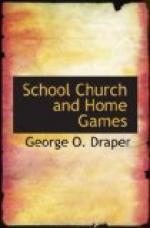The “traffic cops,” by the way, were boy scouts. They had dark blue costumes of cheap drill, trimmed with white braid, and wore white cotton gloves and shiny badges. They really did have power invested in them by the committee to preserve order and keep the crowds moving. At one point they were allowed to stand with a semaphore and hold up the crowd, not allowing anyone to pass who could not show a certain number of tags from the various booths. This tag system was to insure that all would play fair, for there was so much fun just watching other folks spend money that the tightwads might never have taken their hands out of their pockets or opened their purses.
A Racket Around the Candy Booth
Mrs. Peterson, who sells the best bread in town, had charge of the cake archery. You bought arrows for this, three for ten cents, but you could not shoot until a dollar’s worth of arrows had been sold. Then you took your turn at the bow and arrow. The arrow which hit nearest the bull’s-eye got the cake, of course, and it was some cake, if it happened to be one of Abbie Southerland’s angel foods.
The Girls’ Club had drawn the candy table for their share of the fair, and a pretty booth they made of it, using all the tennis nets they could beg, borrow or steal to drape it with and putting up all the candy in ten-cent packages wrapped in white waxed paper to look like tennis balls. Someone got funny and asked why there was such a racket around the candy booth!
The fair lasted three days. What with changing the attractions, keeping fresh food on the refreshment tables, making special attractions for children in the afternoons after school by offering prizes for sports events like sack races, obstacle races, and so on, getting up interest in golf tournaments and baseball series, the place was kept packed from three in the afternoon until midnight.
In The Ladies’ Home Journal, Jan., 1921. Published with the permission of the author, Claire Wallis, and The Ladies’ Home Journal.
CHAPTER V
RACING GAMES FOR PICNICS
In these games participants are divided into a number of equal teams. Each team is lined up in single file behind a base line. A distance line parallel to the base line and about ten yards from it is indicated on the field.
Egg and Spoon Race
A basket of eggs, apples, potatoes or stones is placed in front of each team and a spoon given to the first member of each team. Empty baskets are placed on the distance line opposite the position of each team. At the signal to go the first player on each team, keeping the left hand behind the back, takes one egg from the basket by means of the spoon and carries it on the spoon to the basket from the distance line. Returning to the base line the spoon is handed to the second member of the team who repeats the performance of the first. The game continues until the last player on each team, after carrying the egg forward, returns across the base line. The team first succeeding wins.




